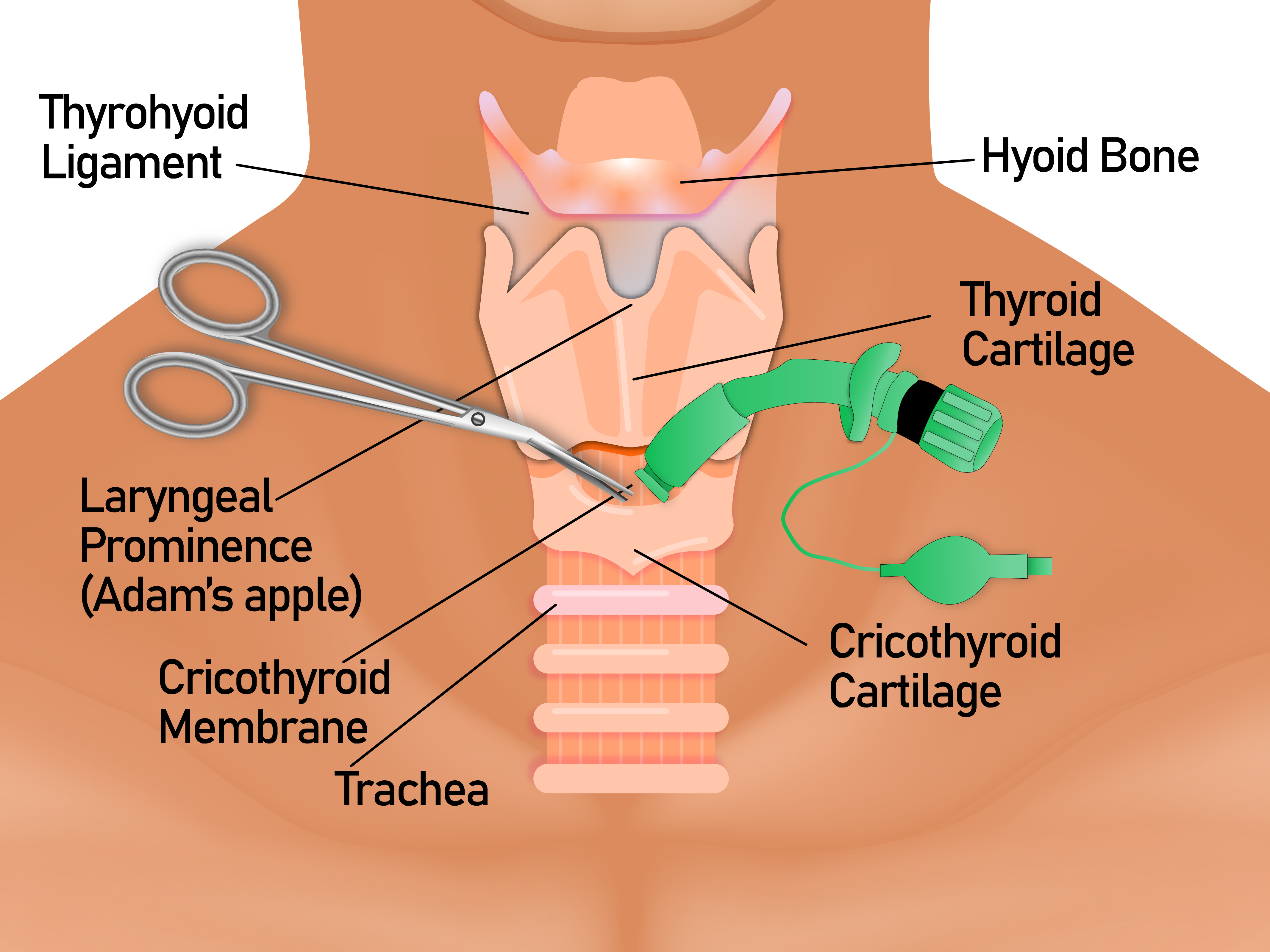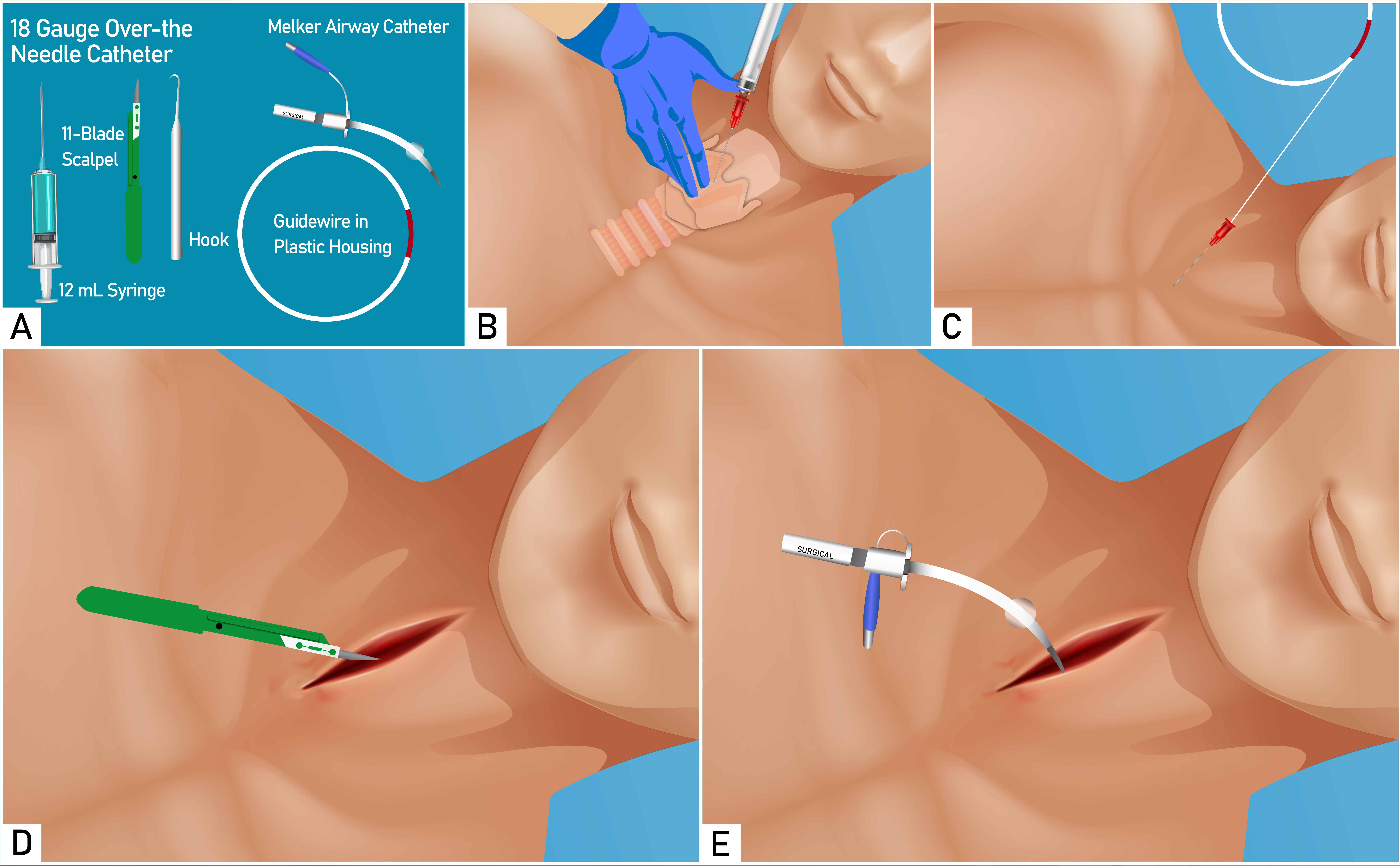[1]
Patel SA,Meyer TK, Surgical airway. International journal of critical illness and injury science. 2014 Jan
[PubMed PMID: 24741501]
[2]
Brantigan CO,Grow JB Sr, Cricothyroidotomy: elective use in respiratory problems requiring tracheotomy. The Journal of thoracic and cardiovascular surgery. 1976 Jan
[PubMed PMID: 1249960]
[3]
Aminov RI, A brief history of the antibiotic era: lessons learned and challenges for the future. Frontiers in microbiology. 2010
[PubMed PMID: 21687759]
[4]
Cole RR,Aguilar EA 3rd, Cricothyroidotomy versus tracheotomy: an otolaryngologist's perspective. The Laryngoscope. 1988 Feb
[PubMed PMID: 3276995]
Level 3 (low-level) evidence
[6]
Paix BR,Griggs WM, Emergency surgical cricothyroidotomy: 24 successful cases leading to a simple 'scalpel-finger-tube' method. Emergency medicine Australasia : EMA. 2012 Feb
[PubMed PMID: 22313556]
Level 3 (low-level) evidence
[7]
Brown CA 3rd,Bair AE,Pallin DJ,Walls RM,NEAR III Investigators., Techniques, success, and adverse events of emergency department adult intubations. Annals of emergency medicine. 2015 Apr
[PubMed PMID: 25533140]
[8]
Wang HE,Donnelly JP,Barton D,Jarvis JL, Assessing Advanced Airway Management Performance in a National Cohort of Emergency Medical Services Agencies. Annals of emergency medicine. 2018 May
[PubMed PMID: 29352616]
[9]
Hamaekers AE,Henderson JJ, Equipment and strategies for emergency tracheal access in the adult patient. Anaesthesia. 2011 Dec
[PubMed PMID: 22074081]
[12]
Scrase I,Woollard M, Needle vs surgical cricothyroidotomy: a short cut to effective ventilation. Anaesthesia. 2006 Oct
[PubMed PMID: 16978312]
[14]
Bair AE,Chima R, The inaccuracy of using landmark techniques for cricothyroid membrane identification: a comparison of three techniques. Academic emergency medicine : official journal of the Society for Academic Emergency Medicine. 2015 Aug
[PubMed PMID: 26198864]
[15]
Campbell M,Shanahan H,Ash S,Royds J,Husarova V,McCaul C, The accuracy of locating the cricothyroid membrane by palpation - an intergender study. BMC anesthesiology. 2014;
[PubMed PMID: 25844061]
[16]
Frerk C,Mitchell VS,McNarry AF,Mendonca C,Bhagrath R,Patel A,O'Sullivan EP,Woodall NM,Ahmad I, Difficult Airway Society 2015 guidelines for management of unanticipated difficult intubation in adults. British journal of anaesthesia. 2015 Dec;
[PubMed PMID: 26556848]
[17]
Higgs A,McGrath BA,Goddard C,Rangasami J,Suntharalingam G,Gale R,Cook TM,Difficult Airway Society.,Intensive Care Society.,Faculty of Intensive Care Medicine.,Royal College of Anaesthetists., Guidelines for the management of tracheal intubation in critically ill adults. British journal of anaesthesia. 2018 Feb
[PubMed PMID: 29406182]
[18]
Quick JA,MacIntyre AD,Barnes SL, Emergent surgical airway: comparison of the three-step method and conventional cricothyroidotomy utilizing high-fidelity simulation. The Journal of emergency medicine. 2014 Feb
[PubMed PMID: 24188608]
[19]
Braude D,Webb H,Stafford J,Stulce P,Montanez L,Kennedy G,Grimsley D, The bougie-aided cricothyrotomy. Air medical journal. 2009 Jul-Aug
[PubMed PMID: 19573767]
[20]
Bramwell KJ,Davis DP,Cardall TV,Yoshida E,Vilke GM,Rosen P, Use of the Trousseau dilator in cricothyrotomy. The Journal of emergency medicine. 1999 May-Jun
[PubMed PMID: 10338233]
[21]
Patel RG, Percutaneous transtracheal jet ventilation: a safe, quick, and temporary way to provide oxygenation and ventilation when conventional methods are unsuccessful. Chest. 1999 Dec
[PubMed PMID: 10593796]
[22]
Bair AE,Panacek EA,Wisner DH,Bales R,Sakles JC, Cricothyrotomy: a 5-year experience at one institution. The Journal of emergency medicine. 2003 Feb
[PubMed PMID: 12609644]
[23]
Erlandson MJ,Clinton JE,Ruiz E,Cohen J, Cricothyrotomy in the emergency department revisited. The Journal of emergency medicine. 1989 Mar-Apr
[PubMed PMID: 2661666]
[24]
Spaite DW,Joseph M, Prehospital cricothyrotomy: an investigation of indications, technique, complications, and patient outcome. Annals of emergency medicine. 1990 Mar
[PubMed PMID: 2310067]


